In the beginning stages of learning how to grow tomatoes, I was under the assumption that I should wait until they were bright red and fully ripe before I picked them from the vine.
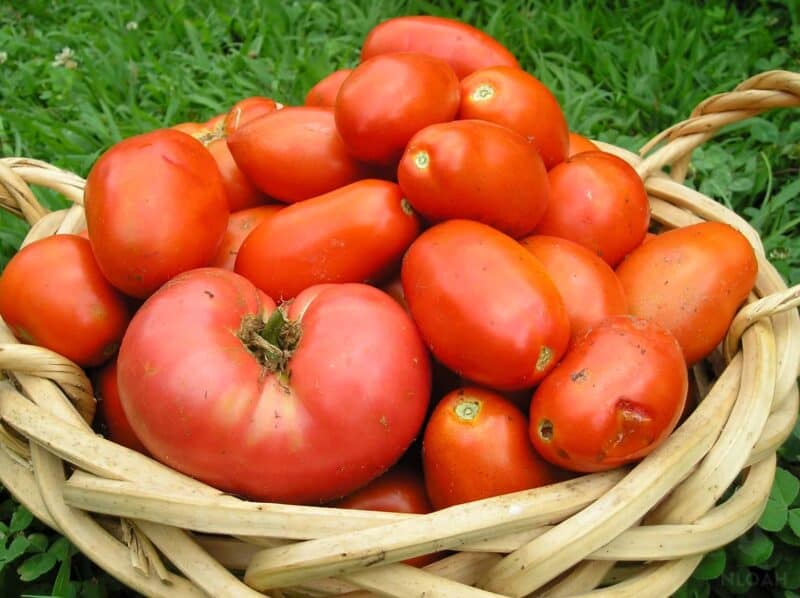
And I lost a lot of tomatoes that way. Experience has taught me that that actually isn’t always the best idea. As a matter of fact, I now very seldom allow my tomatoes to reach their full maturity outdoors.
Waiting until your tomatoes are the perfect shade of red before you pick them would be ideal. However, there are times when you need to pick them before they’re ripe.
When tomatoes get ripe on the vine, insects and birds are more drawn to them, and can do a lot of damage in a single day.
It can be really frustrating to spot a gorgeous red tomato on your plant, only to find upon a closer examination that an entire side has been chewed all up by hungry bugs:
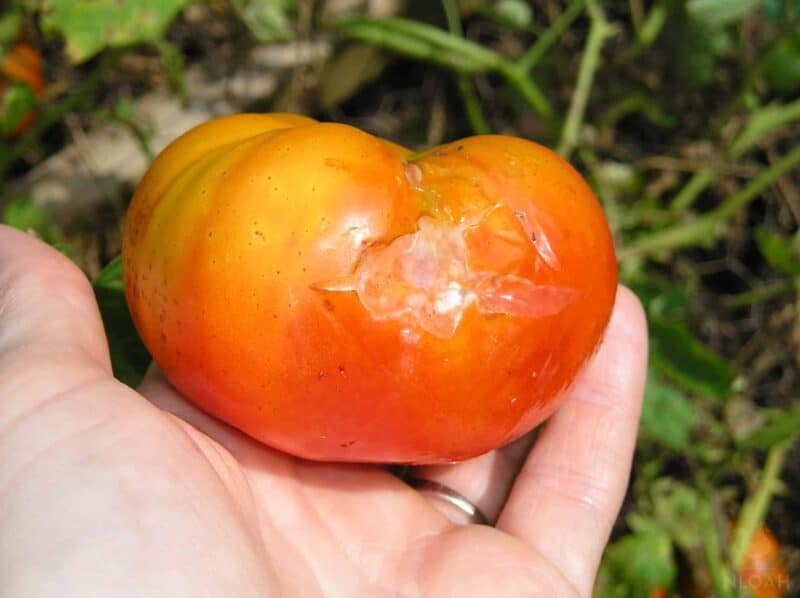
I’ve found that it’s better to pick them before they peak in flavor, reducing the chances of insect damage.
Another reason to pick before a tomato is ripe is to avoid splitting:
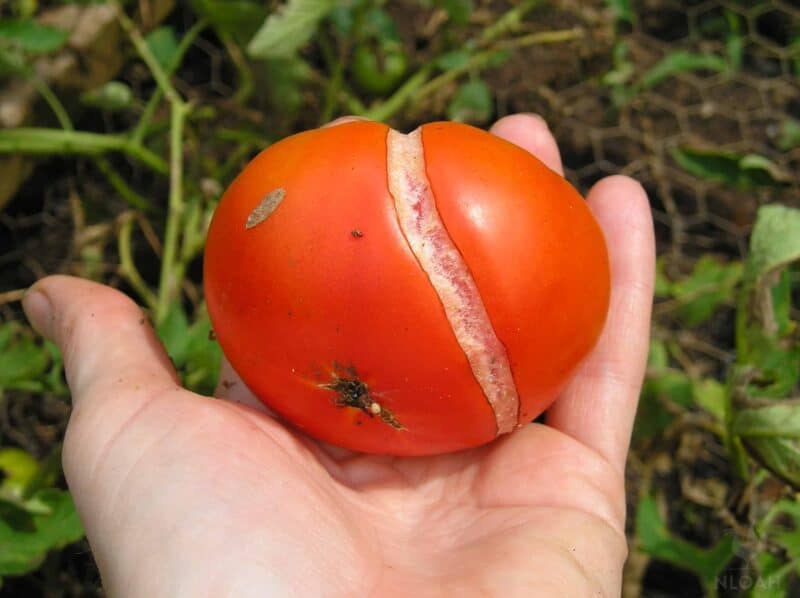
If you’re having a particularly rainy week, and your tomatoes are pretty close to being ripe and/or are already starting to split a little, I recommend that you go ahead and pick them before any more rain comes in.
When tomatoes get too much rain in a short amount of time, they can’t hold all of the water they’ve absorbed and they begin splitting open. Once that skin has split, insects and mold creep in.
Table of Contents:
When To Harvest Tomatoes
When it comes to growing tomatoes, there’s no shortage of information out there to help you get the job done.
But when it comes to harvesting those tomatoes?
Crickets.
Everywhere you turn, you’ll receive contradictory information about when the best time to harvest your tomatoes is. Frankly, there’s no single right answer.
Tomatoes are finicky and are also quite sneaky, too. The problem with them is that they emit gas known as ethylene gas when they are fully mature and green.
When the tomato is green and mature, two growth hormones change and then produce this gas, which ages the cells of the tomato and causes it to soften and turn into a red color – thereby producing the ripe tomato that we know and love.
However, it’s not going to hurt you in order to pick the tomato before it’s ripe. The fruit will still be producing these gases after it leaves the vine, so you can easily ripen tomatoes off the vine. This can help prevent bruising, splitting, and other damages, which I’ll talk about later.
Tomatoes are usually ready to harvest when they are toward the end of the growing season – think late summer. This is when tomatoes are green and firm.
You’ll notice that tomatoes that are purchased at the supermarket are often picked before this stage and allowed to ripen during transport – this results in reduced overall flavor and texture.
You need to toe a very fine line when it comes to ripening your tomatoes at the mature green stage. Watch for the first blush of color to make sure there’s no loss of flavor and essence.
A good indicator that a fruit is ripe is that it will sink in water – but of course, that will be difficult to determine before you actually pick the fruit!
Instead, watch the bottom of the tomato. It will change color there first. Once the first tinge of red appears, harvest time isn’t far away. You can also lightly squeeze the fruit to test for firmness.
In general, most varieties of heirloom tomatoes can reach maturity before they fully turn the appropriate shade, so you will need to pick them when they look almost completely ripe, and when their flesh is between very firm and slightly soft.
If you harvest tomatoes before they’ve completely ripened on the vine (which, again, I can’t recommend enough) you will need to store them indoors to continue the ripening process.
Tomatoes will ripen more quickly if you wrap them in newspaper, because the paper will trap the ethylene gas and speed up the process. Store the tomatoes at temperatures of around 65 degrees or warmer if you wish to quick things.
How to Harvest Ripe Tomatoes
I already told you when tomatoes are ready for harvest. Luckily, harvesting ripe tomatoes involves a lot less guesswork, planning, and storage than harvesting green tomatoes! That being said, you could still use green tomatoes for tasty recipes.
To reiterate, tomatoes are considered ripe and ready to harvest when either:
- the growing season has ended (for determinate varieties, this will be in the late summer to mid fall, or
- when your fruits meet telltale signs of readiness (for indeterminate varieties, this method works best, since you’ll have a consistent harvest throughout the season).
Watch for these signs: the bottom of the fruit is bright red and the fruit is firm but not overly hard, like a green tomato.
As long as the bottom of the tomato is red, it’s safe to harvest as the rest of the fruit will ripen off the vine. However, it’s best to wait to harvest as long as you don’t have any other reasons for harvesting a not-fully-ripe tomato.
To harvest, grasp the fruit firmly but gently. Pull it away from the plant, holding the stem with one hand and the fruit with the other. You will want to gently break the stalk away from the rest of the fruit.
After you’ve harvested your tomatoes, store them indoors. If they need to continue to ripen, consider some of the hacks I mentioned above.
If they’re ripe, store them at 55 to 70 degrees or cooler (like in the refrigerator) if you want to slow the time to spoilage. This will give you some time so you can freeze, can, or eat up your fresh new tomatoes.
In the refrigerator, ripe tomatoes will last up to five weeks. Remember, don’t store unripe tomatoes there because they will not continue to ripen!
The Squeeze Test
The simplest way to check that your tomatoes are ready to harvest is simply to squeeze them – just like you would in the grocery store aisle when buying them.
If the tomato is not to firm yet not too soft, then it’s ready to be picked.
How to Improve Ripening on the Vine
If you find that your tomatoes aren’t ripening, it is likely due to one of these common causes.
The first (and perhaps the most obvious) is that you haven’t given your tomatoes enough time to ripen. Each tomato variety has a specific time it takes to mature.
If you’re growing in a northern climate, it’s crucial that you pick a variety that is designed to ripen in a shorter period of time. Some good options include Early Girl, Stupice, and Glacier. Keep in mind that cherry tomatoes tend to ripen more quickly, too.
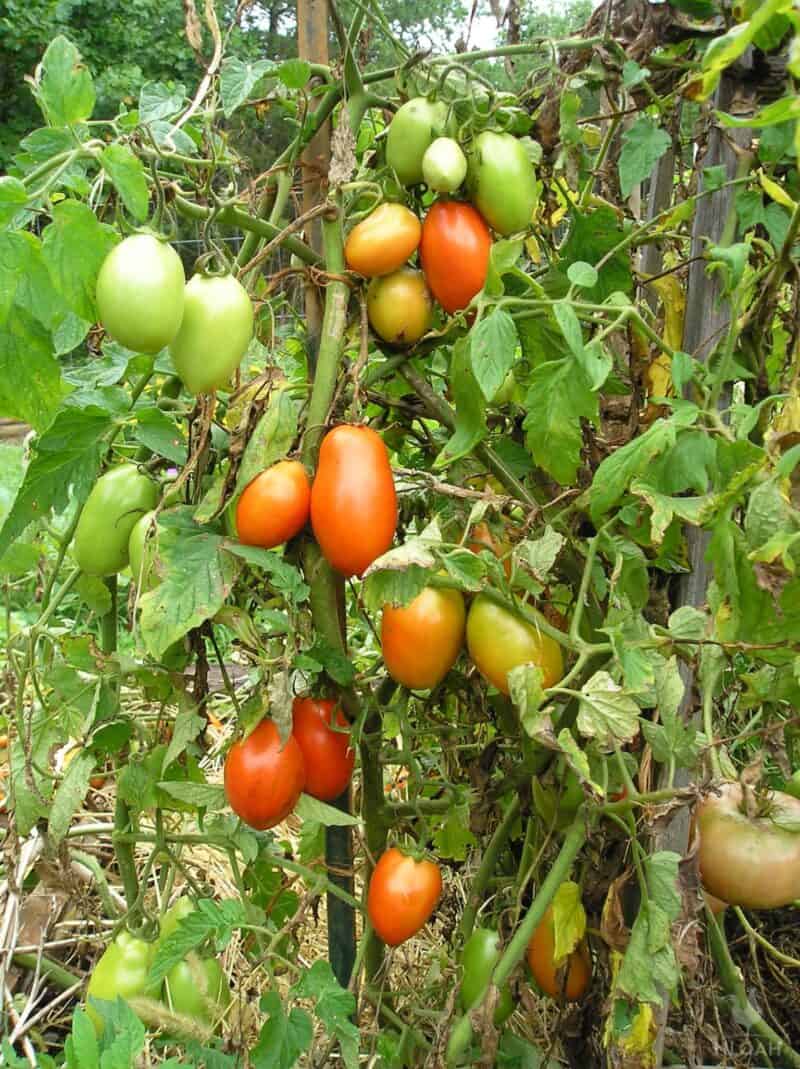
It could also be that the temperatures outside are simply too cold for your fruits to ripen. If your tomatoes are turning pink but not quite becoming a full red, then it might be that your weather is too cold. They might reach a full size but never fully develop their color or flavor.
On the flip side, tomatoes sometimes do not ripen because the temperatures are too hot. Tomatoes generally love heat, but the ideal temperature is between 70 and 80 degrees Fahrenheit.
If they rise higher than that – particularly if it’s also dry – you are going to notice that your fruits stay a mature green instead of a mature red.
The final reason – and the one that might have you slapping your forehead and saying, “Duh! Obvious!” is that your tomatoes might not be turning red because they aren’t actually red tomatoes!
If you’re growing a variety of tomato that is not supposed to turn red when ripe, like a yellow, orange, purple, or even green heirloom fruit, you can wait for years and those tomatoes aren’t going to turn red!
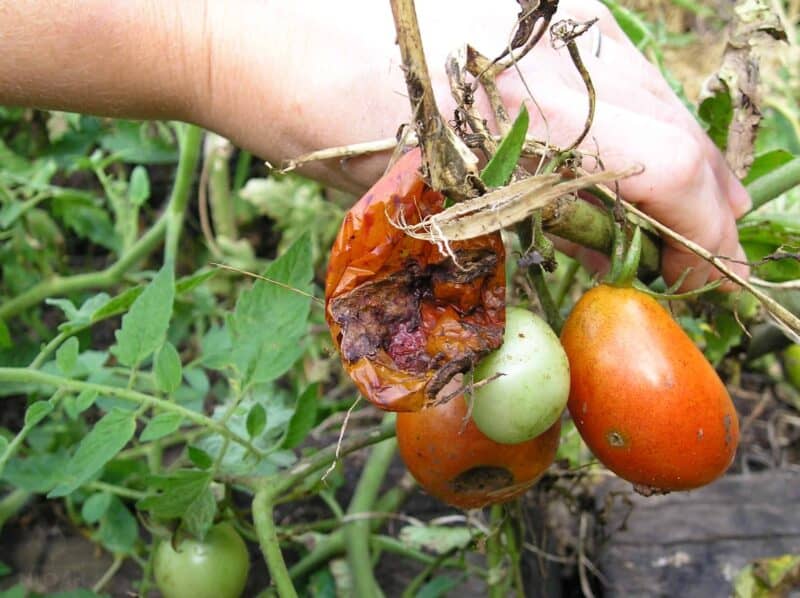
Tomatoes that fail to ripen or turn an odd color can be caused by various diseases, too.
Sun scald cause light colored, leathery patches on the top of the fruit and is the result of too much sun exposure. This can happen to ripened or unripe tomatoes and it often leads to rot.
If your soil is infertile or is lacking in potassium (while having high levels of magnesium) you may notice uneven ripening. Blossom end rot can cause discoloration, too, although it’s usually in the form of large black lesions.
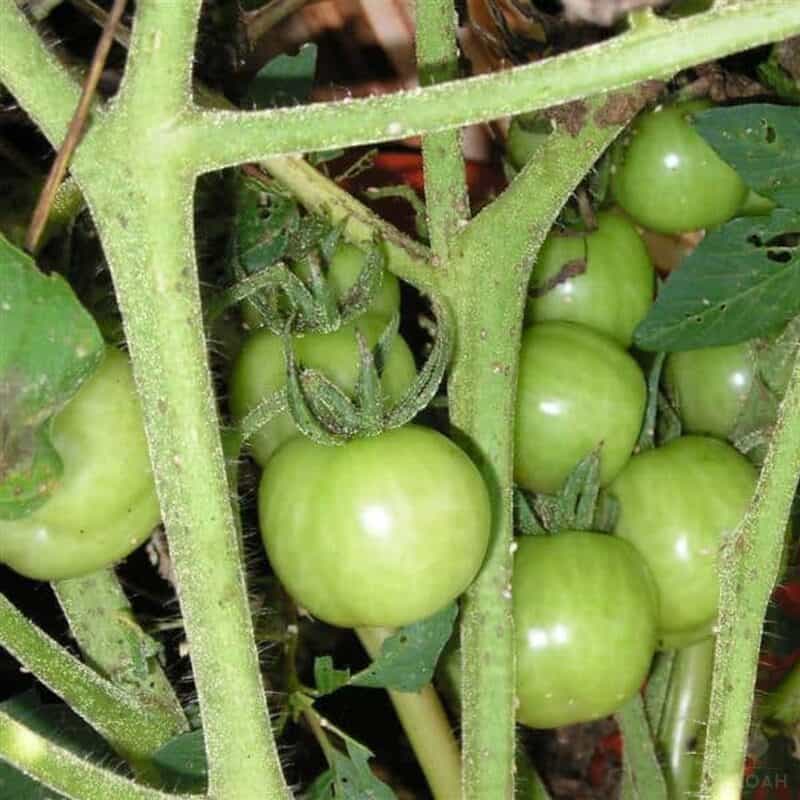
Reasons to Harvest Unripe Tomatoes
Sometimes it’s necessary to harvest unripe tomatoes. Maybe you know it’s time to till the garden under so you can plant a cover crop (i.e., a frost is coming) or perhaps your gardening window has simply closed for the year.
Often, you may find it necessary to harvest tomatoes before they are ripe because you need to control some kind of pest or disease outbreak in your garden.
Another reason you may need to pick unripe, and even green tomatoes is when you know you won’t be able to harvest them when they reach their peak. Maybe you’ll be away from home during their ripening, or maybe a frost is expected to hit your area.
Yes, you can pick completely green tomatoes and leave them out on the counter and they’ll continue ripening over the course of a few weeks.
Also, tomatoes will stop ripening when you have several really hot days in a row. Instead of continuing to ripen on the vine, they’ll begin to rot.
So if the weather man is forecasting several days of scorching sun, this would be another good time to pick your tomatoes before they look 100% ready.
The cool thing about picking tomatoes before they’re ripe is that they’ll continue to ripen indoors. Just lay them out in a single layer and leave them somewhere warm for a few days (never in the fridge). They’ll turn a beautiful blush in no time.
Uses for Unripe Tomatoes
Don’t despair if you need to harvest your tomatoes before they are totally red. There are plenty of uses for green tomatoes, too, and they’re perfectly safe to eat.
Harvesting green tomatoes won’t hurt the plant, nor will it hurt the fruits. A common misconception is that if you harvest the tomato fruits before they are ripe, it will encourage the plant to make more fruits.
Unlike some vegetables (like zucchini) where this is true, with tomatoes that is unfortunately not the case. Harvesting green tomatoes won’t stimulate more fruit production because fruit production is related to air temperature and nutrient availability.
If you have a ton of green tomatoes that you know are not going to ripen on the vine, go ahead and pick them. Just make sure they aren’t rock-hard when you squeeze them.
Once you get them inside, you can allow them to finish ripening or use them. If you want them to finish ripening, don’t store them in the refrigerator.
The refrigeration will destroy the flavor and halt any ripening. Instead, let them sit on a countertop or windowsill at room temperature. You can also wrap them in newspaper.
Another common trick is to place your unripe tomatoes in a bag with another fruit that emits ethylene gas, such as an apple or a banana. This will help speed up the ripening process.
Alternatively, you can use up your green tomatoes in your cooking – in fact, you can even preserve them for longterm storage if you wish. Instead of tossing them into the trash, you might consider making one of the following recipes:
- Green Tomato Relish
- Fried Green Tomatoes
- Fried Green Tomato Parmesan
- Mexican Salsa Verde (you can also use green little tomatillos for this one!)
- Green Tomato Pie
- Green Tomato and Bacon Soup
- Green Tomato Bread
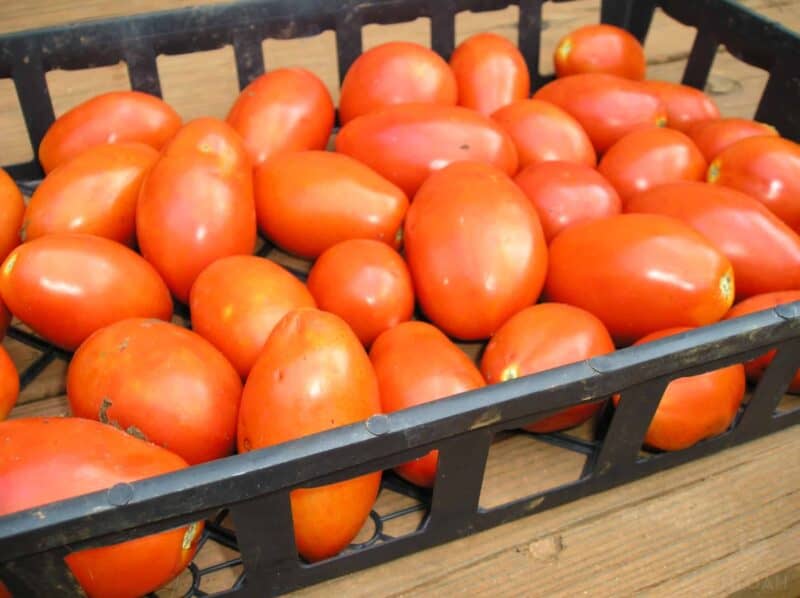
A Few More Tips
If you’re still not sure where to turn when you’re getting ready to harvest tomatoes – whether they’re red or green or somewhere in between – here are some extra tips for best results:
- Keep damaged tomatoes away from good ones while ripening, in case they start to rot before they fully ripen.
- Cut the tomatoes from the plant instead of pulling them off. They store best with the stem attached.
- Storing tomatoes in cooler temperatures (50-60*F) will slow their ripening and allow you to stretch the season.
- If the tomato’s stem has been removed, some experts recommend that you store the tomato stem-side down to reduce the chances of it rotting.
Frequently Asked Questions
Ideally, you’ll want to harvest them early in the morning, before the dew evaporates. If that’s not possible, you can pick them in the evening as well.
This usually happens when it’s too hot (over 90 F / 32 C), and the plants stop producing the two pigments that give them color, carotene and lycopene. The ideal ripening temperature is 77 F (25 C).
Definitely, and there are easy ways to ripen them once you do. Do this if you expect pests to feast on your tomatoes before you get a chance. This will also avoid your tomatoes splitting.
Sure, so long as no pests got a chance to munch on them first.
This depends on the variety, so you may want to check the seeds packet to find out.
What have you found to work best? Do you let your tomatoes fully ripen on the vine, or do you bring them indoors to finish ripening?
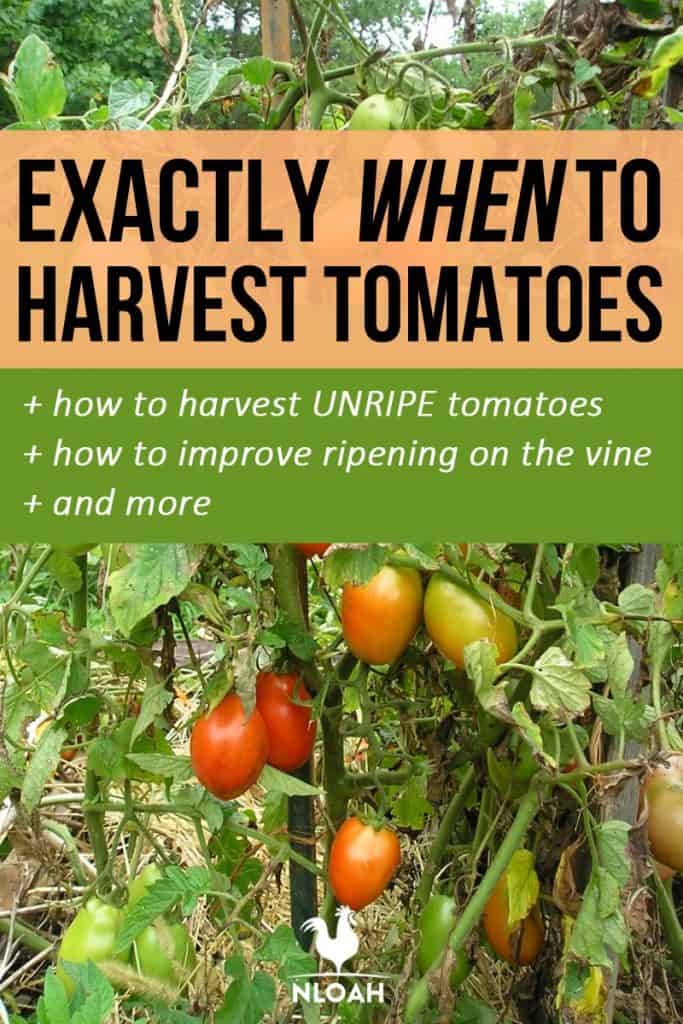

A city girl learning to homestead on an acre of land in the country. Wife and homeschooling mother of four. Enjoying life, and everything that has to do with self sufficient living.

At the end of the season, I pull the vines with the tomatoes still attached and hang them in my greenhouse (garage, basement, or kitchen) and let the remaining fruit ripen.
your tips are a Godsend thanks s mmuch off out now to pick my green toms!!!
I know this has to do with nothing but the actual tomato, but the lesson of life I gained, it’s like a new revelation of life. Thank you.
what to do with red tomatoes that have green gooey inside with quite dark seeds?
can I blanch and or wash and freeze them ?
I am hopeful that I can put them up for later use.
Thank You Kindly
I don’t think I’ve ever had red tomatoes that were green and gooey inside. What variety are they, do you know?
As October is ending in Michigan, it is getting cold – low 40’s at night, possible frost. I have some monster beef steak tomatoes (10-15) still in the plant. Should I pick and ripen indoors, or wait???
I’d pick them before frosts come in. I’ve still got some on the vines as well that need to be picked really soon.
We live in the Rockies Mountains where are first frost can be first part of Oct. If I see a tomatoes just starting to ripen if I pick it will it help the others start changing colors?
Thanks for the other tips.
I also put green tomatoes try to keep on a vine into a paper bag and majority will ripen.
TC,
I don’t think picking one tomato will help the others ripen more quickly. But I’d definitely pick them all before a hard frost hits. Or try covering them in a tunnel of plastic.
Where I live, the sun later in the day can be too hot for plastic. I use old sheets or frost blaket wrapped around some stakes.
Hi TC, Its mid sept. here in southern Ohio. My tomatoes are ripening slowly. I have 10 or so small ones about 1″ and smaller still trying to grow. Will picking these off help the others ones get bigger and ripen faster? the small ones won’t even get big enough to eat before the fall cold sets in. My plants are in containers on my deck!
You might try making a reflective shield using aluminum foil around the base of the plant to direct some of the sun’s heat onto the plant. That might make them ripen a little more quickly.
Also (i know this isnt tomato related but…) if u hear of anyone in michigan looking for roosters let me know! I have 3 beautiful bardrocks to get rid of (4mos old) they were supposed to be hens!
Planted our first and “organic” garden this year (80’x60′!) in Michigan. We have several types of tomatoes from grape to heirlooms! The cherry’s are the only ones that are turning red 🙁 could this be due to the fact that we’ve had a LOT of rain and much cooler temps than usual this summer? (We used our compost that we’ve been making for several years now and brew a compost “tea” to foliar) Everything else is doing great except our cukes which are producing but I believe now have disease…any suggestions?
Renee,
Are the tomatoes just staying green and then rotting? Or, do you think they might just need a little longer to ripen?
I never thought of picking them before and bringing them in. Only when they fall off before they are ready do I put them on the picnic table to ripen.
Thanks for sharing this great idea.
Tricia,
You made me think of the country homes I pass sometimes that have tomatoes lined up on their porch railing or on a table near the garden 🙂
Your Romas are lovely!
Thank you!! 🙂
Very useful information! Picked some unripe today, and have no regrets now! Posted new pics of my tomatoes to my blog today.
Great post! 🙂 We are set to have a lot of tomatoes (usually do each year) and we usually run into those problems you talked about. Thanks so much for the wisdom and now I’ll be picking some tomatoes early!
I usually pick tomatoes when they are red but firm – what I think of as salad tomatoes, so they can be sliced easily. If I’m cooking with them, making a sauce, then they can be riper and softer and therefore sweeter too. The only time I pick green tomatoes is towards the end of the season when I am clearing the polytunnel and then I keep them on newspaper covered trays while they ripen. My grandson likes to eat the very small Gardeners’ Delight tomatoes like sweets.
Sandra Chubb http://www.rainbowcottagesinfrance.com http://livingin22.blogspot.com
Kendra- Just curious but when you pick the tomatoes before they are ripe, do they still have the full health benefits? And how about flavor? I have lost many tomatoes by leaving them on the plant just a little to long. I guess I was just always under the impression for them to be at their best they needed to stay on the vine until fully ripe. It would be great if I could pick them a little early!!
Jen,
You know, I wondered the same thing. From experience, the taste isn’t really any different once the tomato has fully ripened. I wouldn’t be able to tell you a vine ripened tomato from a countertop ripened one. I couldn’t find much information about the nutrient value. From what I understand… and anyone is free to correct me on this… green tomatoes have some different nutrients from red ones, but they are both good for you. If you want to get more tomatoes from your plants, it’s definitely better to pick them a little early and let them ripen indoors 🙂
I have found out that in order for the green tomatoes to turn red after you pick them there must already be a slight blush of color started ( just a tad )if they are solid green then most likely it will stay green and not turn red .
Nancy, you are right, and I’m glad you clarified that. The tomatoes can’t be completely immature, or they will not ripen. They do have to be full sized and *just* starting to turn from that dark green color before they will continue to ripen. Thanks again!
Wonderful to know! This is my first year with tomatoes, and DH and I have been having the “To pick or not to pick” argument.
One question- I’m in the south- days are regularly above 90, with stretches of 98+. Is there a set temperature that I should be on the lookout for? Like, if the temp will be 95 for 3 days, go ahead and pick them? And, if I’m picking them to avoid the heat rot, should I pick full-sized green ones too?
Theresa,
I think the best thing you can do is keep a close eye on them when you have long stretches of really high temps. If you notice the tomatoes aren’t turning redder (or pinker/oranger, depending on the variety), but are staying about the same color even after 2-3 days, I’d pick them. They should gradually and quickly be turning darker in shade day by day. If the green ones aren’t turning more of a blushed color over a couple of days, you might need to pick them. Hope that helps a little!
Last year I picked the rest of my cherry tomatoes right before Thanksgiving to avoid a hard frost. We ate the last ones right before Christmas. If you do let tomatoes ripen inside, be sure to check them often as they sit around ripening. One problem we had was some would start to rot before they got ripe. They mushed up on the bottom, split open and we ended up with fruit fly larvae crawling around. We had to check daily because those fruit flies will turn into a horde very quickly.
Absolutely right, Matt. You definitely want to check them daily, especially if you have any that are already split or bruised. Thanks!
thank you for those great tips !!! Will keep them in mind from now on. your tomatos look fantastic !!!
~nik~
Thanks, Nik 🙂 This is probably our best tomato year to date 😉
Two more good reasons to pick before fully ripe: 1. birds and squirrels are attracted to them once they start turning color. 2. Eating them! Green tomato relish and, of course, fried green tomatoes, are must haves in our home.
Thanks, Becky! I’ve never had a problem with squirrels eating my tomatoes (probably too many other things around here for them to get into), but I do know of others who really have had to fight the squirrels. Thanks for adding this on!
Your Romas look fabulous! Thanks for the tips!
Thanks, Daisy! My Romas have definitely out-performed the other varieties I planted this year.
Hi Kendra,
Once again an informative post. I will check my tomatoes this morning!
Regards,
CB
Glad I could be of some help, City Boy Hens! 🙂
Thanks for the tips! I had the same experience as yours. If I leave my tomatoes too long the bugs get to them before me. I didn’t know the green ones will ripen indoors. My toddler sometimes gets her hands on a green one and I usually throw it in the compost. I’ll try to bring it inside next time.
Oh yes, Lee, definitely bring any green ones that are picked prematurely indoors. 🙂 The only ones you need to toss in the compost pile (or chicken run) are the rotten ones, lol. I hope you have a great harvest!